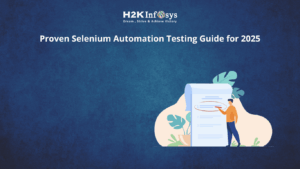The process of validating the effectiveness and performance of a newly developed software in tech is known as Automation Testing. Most times, many have different misconceptions about tech-related processes and ignore them. However, automation testing is one of the most relevant fields that helps with reducing the stress of developing software with bugs and failures.
If you’re curious about how this is done, here’s an article to explain the process of automation testing. It’ll sure be an interesting read, so let’s get started.
What is Automation Testing?
As discussed earlier, automation testing involves checking the developed software to ensure it’s fit for the end-users. The process of automation testing begins from the conception of the software and experts are allowed to understand the purpose of the software before beginning.
Before now, software testing was done manually for bugs and other defaults. The manual testers act as the end-users while trying to perform the process. On the other hand, automation testing makes use of testing tools to perform the testing process. Automation testing done with these tools gets results collated, analyzed, and understood by the experts. This is the major difference between both types.
It is advised for testers to begin the testing processes as development continues because it helps with easy bug detection. In cases where the development process has ended, testing may be quite difficult with lots of need for repairing faults.
How does Automation Testing Work?
The automation testing process is easily explained in 5 steps. These are:
- Selection of preferred test tools
- Defining automation testing scope
- Developing automation testing tool strategy
- Executing test script
- Automation test maintenance
Let’s get to this one after the other.
1. Selection of Preferred Test Tools
Automation testing is done using different test tools. The first stage to perform the automation testing process is deciding the test tool to be used. These best tools have specifics, uses, requirements, and other factors. So, the selection of a particular tool depends on what the project entails. For example, selenium test tools support the development of web applications using numerous programming languages while others may not. Enrolling in a Selenium certification course will further help you understand the use of the tool and its functionality.
Ensure you understand the test tool and its functions well before proceeding with its use on the project.
2. Defining Automation Testing Scope
The next step after the selection of the tool is to define the automation test scope. The automation test scope is identifying the area in which the automation testing will be used. In a testing process, both testing types can be used depending on the project and the expert. With the best selenium certification, you’ll understand the areas where these types can come into play perfectly. This is one of the important areas to note when defining the scope.
Others include knowing:
- The technicality of test cases
- The major characteristics important in the project
- The appearance of business tools in the project
- The acceptance of the same test cases during cross-browser testing
These and other areas are quite important steps to understand before proceeding with the testing.
3. Developing automation tool Strategy
The next step requires working with the previous data to create a strategy. An understanding of the testing tool and other factors will help you create an effective strategy to guide you throughout the testing process.
It’s important to always work with a strategy for automation testing. Also, it’s important to always document the required information as it simplifies the process and leads to better performance.
4. Executing Test Script
The best stage is executing the test script. The test script will be launched and made to run on the tool. The testing of the test script will lead to checking for potential errors that may come up during the actual test period.
Executing test scripts can be done simultaneously on different systems and at any time of the day.
5. Automation Test Maintenance
The test maintenance stage is the last involved in the testing process. This is designed to check whether the added tools are well aligned with the system. This is also a very important process that plays a major role in deciding the outcome of the software testing.
Conclusion
The automation test process requires patience and good knowledge before venturing into it. The best news is that you can always attend classes online and get the right certifications like the selenium certification course to upgrade your skills.
























